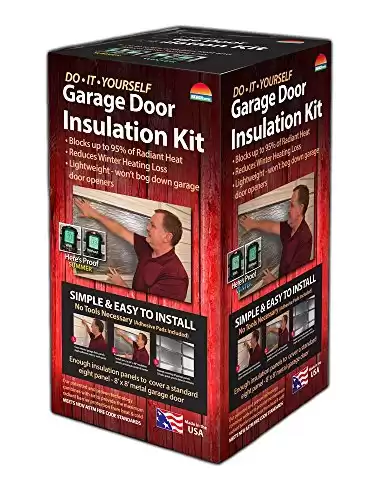The Benefits of Garage Door Insulation:
Enhancing Comfort and Efficiency

Garage doors are a part of our homes, providing security and convenience. However, many homeowners overlook the importance of garage door insulation. Insulating your garage door can bring numerous benefits, from improving energy efficiency to enhancing comfort and reducing noise levels. In this blog post, we will delve into the advantages of garage door insulation and explore why it should be a priority for every homeowner.
The Benefits of Garage Door Insulation
1. Improved Energy Efficiency
One of the primary reasons to insulate your garage door is to enhance energy efficiency. Garages are often connected to the main structure of the house, making them susceptible to outside temperatures. Without proper insulation, your garage can become a significant source of heat loss during winter and heat gain during summer.
By insulating your garage door, you create a thermal barrier that helps maintain a more stable temperature inside the garage. Insulation materials, such as foam panels or reflective insulation, reduce heat transfer, keeping the garage cooler in summer and warmer in winter. This improved insulation not only benefits the garage but also impacts the adjacent rooms and overall energy consumption of your home.
2. Enhanced Comfort
Many homeowners utilize their garages for various purposes beyond parking vehicles. They may use it as a workshop, a home gym, or even as an additional living space. Proper insulation helps create a more comfortable environment, regardless of how you utilize the garage.
Insulation provides better temperature control, ensuring that the space remains comfortable year-round. During hot summer months, insulation minimizes the heat gain from the sun, preventing the garage from becoming excessively hot. In winter, it helps retain heat, making it easier to warm the garage if needed. By regulating the temperature, insulation makes the space more enjoyable for hobbies, workouts, or spending time with family and friends.
3. Noise Reduction
Another advantage of garage door insulation is the reduction of noise transmission. Insulation materials act as sound barriers, dampening noise from both inside and outside the garage. If you live in a noisy neighborhood or have adjacent rooms to the garage, insulating your garage door can significantly diminish the amount of noise that infiltrates your living spaces.
Insulation materials with high soundproofing properties, such as polyurethane foam, can absorb sound waves and prevent them from resonating through the garage door. This is particularly beneficial if you use your garage for activities that generate noise, such as power tools or playing music. Furthermore, it can help maintain a peaceful atmosphere within the house by minimizing external noises, like traffic or neighborhood activities.
4. Protection from External Elements
Insulating your garage door not only improves energy efficiency and comfort but also provides a layer of protection against external elements. Whether it’s extreme temperatures, moisture, or dust, insulation acts as a barrier, preventing these elements from infiltrating the garage.
In regions with harsh climates, insulation helps maintain a more stable temperature, reducing the risk of freezing pipes or extreme heat damage. It also keeps moisture and humidity levels in check, preventing the growth of mold and mildew. Moreover, insulation blocks dust and debris from entering the garage, keeping the space cleaner and minimizing the amount of cleaning required.
Different Types of Garage Door Insulation
There are several types of insulation available for garage doors, each with its own pros and cons. Here are some common options:
1. Polystyrene Panels:
– Pros: Polystyrene panels are affordable, lightweight, and easy to install. They provide good insulation value and can reduce noise transmission.
– Cons: They have lower insulation performance compared to other materials and may be less effective in extreme climates.
2. Polyurethane Foam:
– Pros: Polyurethane foam provides excellent insulation properties and has a high R-value (thermal resistance). It offers superior energy efficiency, soundproofing, and structural rigidity.
– Cons: It is more expensive than polystyrene panels and requires professional installation. Repairs or modifications can be challenging due to the foam’s rigid nature.
3. Reflective Insulation:
– Pros: Reflective insulation consists of a radiant barrier that reflects heat back towards its source. It is easy to install, lightweight, and works well in hot climates by reducing heat gain.
– Cons: Reflective insulation is less effective in colder climates as it primarily focuses on reflecting heat rather than providing thermal resistance. It may not offer as much soundproofing as other materials.
4. Fiberglass Batt Insulation:
– Pros: Fiberglass batts are commonly used for wall and ceiling insulation, but they can also be used for garage doors. They offer good thermal resistance and are relatively inexpensive.
– Cons: Fiberglass batts can be more challenging to install in garage doors due to their flexibility. They may also sag over time and lose some insulation value if not installed properly.
5. Cellulose Insulation:
– Pros: Cellulose insulation is made from recycled paper or plant fibers and provides good thermal performance. It has high sound absorption capabilities and can be blown into cavities for effective coverage.
– Cons: Cellulose insulation may require professional installation due to the specialized equipment needed for blowing. It can settle over time, reducing its insulation effectiveness.
6. Spray Foam Insulation:
– Pros: Spray foam insulation provides excellent thermal resistance and air sealing properties. It expands to fill gaps and cavities, creating a seamless insulation layer.
– Cons: Professional installation is typically required for spray foam insulation. It is more expensive than other insulation options and may release harmful fumes during installation if not done correctly.
It’s important to consider factors such as climate, budget, installation requirements, and desired insulation performance when choosing the right insulation material for your garage door. Consulting with a professional can help you make an informed decision based on your specific needs and preferences.
How to Install Garage Door Insulation
Here are the general steps for installing garage door insulation:
Tools you will need:
1. Measuring tape
2. Utility knife or scissors
3. Straightedge or ruler
4. Marker or pencil
5. Adhesive (if required)
6. Safety goggles and gloves
Step-by-step installation process:
1. Measure the panels: Start by measuring the dimensions of each individual garage door panel. Take accurate measurements of the width, height, and thickness of each panel.
2. Choose the insulation material: Select the insulation material that suits your needs and budget. Options include polystyrene panels, polyurethane foam, reflective insulation, fiberglass batts, cellulose insulation, or spray foam.
3. Prepare the workspace: Clear the area around the garage door and ensure there is enough room to work comfortably. Keep the garage door fully open during installation.
4. Cut the insulation material: Using a straightedge and a utility knife or scissors, cut the insulation material according to the measurements of each door panel. Double-check the measurements before cutting to ensure accurate sizing.
5. Install the insulation material: Place the cut insulation material onto each panel, ensuring a snug fit. Some insulation materials may require adhesive to secure them in place. Follow the manufacturer’s instructions for adhesive application if needed.
6. Trim excess insulation: Trim any excess insulation using a utility knife or scissors, ensuring a neat and clean appearance.
7. Repeat for all panels: Install the insulation material on each individual panel of the garage door, repeating the same process.
8. Check for proper alignment: Once the insulation is installed on all panels, close the garage door to check if the panels align correctly. Adjust or trim the insulation if needed to ensure proper alignment and smooth operation of the door.
9. Test the garage door: After installation, test the garage door to ensure it opens and closes smoothly without any obstruction or interference from the insulation.
10. Clean up and maintenance: Clean up any debris or trimmings from the installation process. Regularly inspect the insulation for any damage or signs of wear, and replace as necessary to maintain its effectiveness.
Remember to refer to the manufacturer’s instructions specific to your chosen insulation material for any additional installation steps or recommendations.
Note: It is essential to prioritize safety during the installation process. Wear safety goggles and gloves to protect yourself from any potential hazards while handling insulation materials or using cutting tools.
Here are ten frequently asked questions (FAQs) about garage door insulation, along with their answers:
1. Why should I insulate my garage door?
Insulating your garage door improves energy efficiency, enhances comfort, reduces noise, and protects against external elements. It also helps maintain a more stable temperature in the garage and adjacent living spaces.
2. Can I insulate my existing garage door?
Yes, you can insulate an existing garage door. There are various insulation options available, such as foam panels, reflective insulation, or DIY insulation kits, that can be retrofitted to your garage door.
3. How much does garage door insulation cost?
The cost of garage door insulation depends on the insulation material, size of the door, and whether you choose professional installation or a DIY approach. On average, insulation materials range from $50 to $200.
4. Will garage door insulation reduce outside noise?
Yes, garage door insulation helps reduce noise transmission from both inside and outside the garage. Insulation materials with soundproofing properties absorb and dampen sound waves, creating a quieter environment.
5. Can I insulate my garage door myself?
Yes, many homeowners choose to insulate their garage doors themselves using DIY insulation kits. These kits come with the necessary materials and instructions for easy installation.
6. How thick should garage door insulation be?
The thickness of garage door insulation depends on the insulation material used. Common insulation thicknesses range from 1/2 inch to 2 inches. Thicker insulation generally provides better insulation properties.
7. Will insulating my garage door save energy?
Yes, insulating your garage door can help save energy by reducing heat loss during winter and heat gain during summer. It creates a thermal barrier that minimizes temperature fluctuations and decreases the workload on your HVAC system.
8. Can garage door insulation prevent condensation?
Yes, garage door insulation can help prevent condensation by reducing temperature differentials between the garage and the outside environment. Insulation materials act as a barrier, preventing warm, moist air from contacting cold surfaces and causing condensation.
9. How long does garage door insulation last?
The longevity of garage door insulation depends on the quality of the insulation material and its exposure to wear and tear. Well-maintained insulation can last for many years, providing long-term benefits.
10. Will insulating my garage door affect its operation?
Properly installed insulation should not significantly impact the operation of your garage door. However, it is essential to choose lightweight insulation materials and ensure they are installed correctly to avoid excessive strain on the door’s mechanisms.
Investing in garage door insulation brings a host of benefits that positively impact your home’s comfort, energy efficiency, and overall functionality. By creating a thermal barrier, insulation ensures a more stable temperature inside the garage, reduces noise transmission, and offers protection against external elements. Whether you use your garage for storage, hobbies, or as an extension of your living space, insulating the garage door is a wise decision that will enhance your daily life and contribute to a more sustainable home.
Take the initiative to consult a professional or research suitable insulation options to improve your garage door’s performance. With the right insulation in place, you’ll enjoy a more comfortable and efficient space, while also saving on energy bills in the long run.










